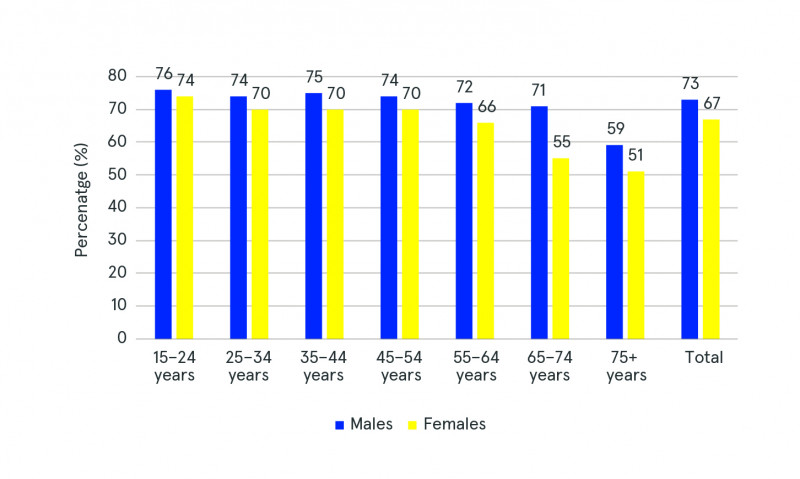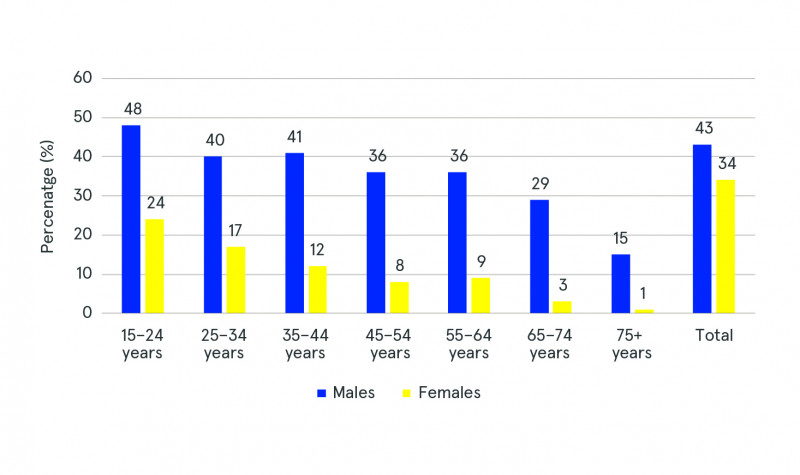Doyle, Anne  ORCID: https://orcid.org/0000-0002-2776-3476
(2024)
Alcohol findings from Healthy Ireland Survey 2023.
Drugnet Ireland,
Issue 87, Winter 2024,
pp. 1-6.
ORCID: https://orcid.org/0000-0002-2776-3476
(2024)
Alcohol findings from Healthy Ireland Survey 2023.
Drugnet Ireland,
Issue 87, Winter 2024,
pp. 1-6.
| Preview | Title | Contact |
|---|---|---|
|
PDF (Drugnet issue 87)
2MB |
The ninth wave of the Healthy Ireland Survey, commissioned by the Department of Health and carried out by Ipsos B&A, involves a representative sample from the general population aged 15 years and over to increase knowledge of the population’s health and health behaviours.1 The survey is in accordance with Ireland’s Well-being Framework 2023, which seeks to measure the current status of Ireland’s performance as a nation based on a set of indicators. These focus collectively not only on economic standing but also equality issues and sustainability.2 A number of these indicators are incorporated into the survey.
Methodology
Telephone interviews took place between October 2022 and April 2023 with approximately 7,500 respondents. Along with questions about alcohol use, the survey examined general health, tobacco use, illicit drug use, mental health, use of general practitioners (GPs) and other health services, suicide awareness, antibiotic usage, quality of life, and social connectedness. Questions about alcohol use are routinely asked in each wave of the survey, but in the 2023 survey, additional alcohol questions were included to better understand the public’s observation of labels on alcohol products. Section 12 of the Public Health (Alcohol) Act 2018 was signed into law in May 2023, which provides for more comprehensive health labelling of alcohol products. However, to allow businesses/producers sufficient time to prepare, it will not be mandatory until 2026.3 Therefore, it is important that baseline information be available to gauge how much the general public notice these labels in their current limited state and the extent to which they interact with the labels, so that comparisons can be made following the commencement of Section 12 in 2026.
Main findings on alcohol
Alcohol use
Seventy per cent of the population aged 15 years and over reported consuming alcohol during the past 12 months, 73% of males and 67% of females. This was a decline since the 2018 Healthy Ireland Survey (the last time alcohol use was measured by the past 12 months), which was 75% overall (78% males vs 72% females).4 In 2023, those aged 15–24 years (75%) were more likely to report consuming alcohol in the previous 12 months, particularly males (see Figure 1).
Drinking at least once a week was reported by 38% of respondents, a decrease since 2018 (41%). In 2023, drinking at least once a week was more common among those aged 55–64 years (48%), particularly males in this age group (52% vs 43% females). Males aged 65–74 years were also likely to report drinking at least once a week (53%), considerably higher than females in the same age group (34%).

Figure 1: Percentage of respondents who consumed alcohol in the previous 12 months, by sex and age

Figure 2: Percentage of respondents who reported binge drinking on a typical drinking occasion, by sex and age
Binge drinking
Almost one-quarter (24%) of the population reported binge drinking on a typical drinking occasion – defined as drinking six standard drinks or more in one sitting – lower than that reported in 2018 (27%). Males (43%) were more likely to report binge drinking compared with females (34%), which applied to all age groups (see Figure 2).
Almost one-quarter (24%) of parents of children aged less than 18 years binge drink on a typical drinking occasion; this was more commonly reported among fathers (39%) than mothers (11%).
Alcohol packaging and advertising awareness
Over one in every 10 respondents reported often or always seeing health messages when looking at alcohol packaging, while 59% never see health messages. Just 6% of respondents reported that they often or always read or look closely at health warning messages on alcohol products. The most common warnings noticed were about alcohol content (28%), drinking during pregnancy (14%), and consumption warnings (13%).
Often or always seeing or hearing health messages for alcohol advertising was reported by 16% of respondents, although 47% of respondents reported that they never hear or see such messages for alcohol advertising. Of those who reported seeing or hearing health warning messages on alcohol advertising, 8% reported paying close attention to the information. Just 6% of respondents sought out information on the effects of drinking alcohol in the previous 12 months.
Conclusion
Alcohol use remains high among the Irish population; however, it has decreased since 2018 when alcohol use was measured as last-year use. (Surveys in between these time periods asked about alcohol use in the last 6 months and are therefore not comparable.)
This is the first time that the Healthy Ireland Survey has asked about health warnings on alcohol products or in alcohol advertising. This information provides a valuable baseline for which to compare future data, as health warning labels will become mandatory in 2026.5
A Substance use and dependence > Prevalence > Substance use behaviour > Alcohol consumption
B Substances > Alcohol
G Health and disease > Substance use disorder (addiction) > Alcohol use disorder
J Health care, prevention, harm reduction and treatment > Health related issues > Health information and education
MA-ML Social science, culture and community > Sociocultural aspects of substance use > Societal attitude toward substance use / public opinion
MP-MR Policy, planning, economics, work and social services > Marketing and public relations (advertising)
VA Geographic area > Europe > Ireland
Repository Staff Only: item control page